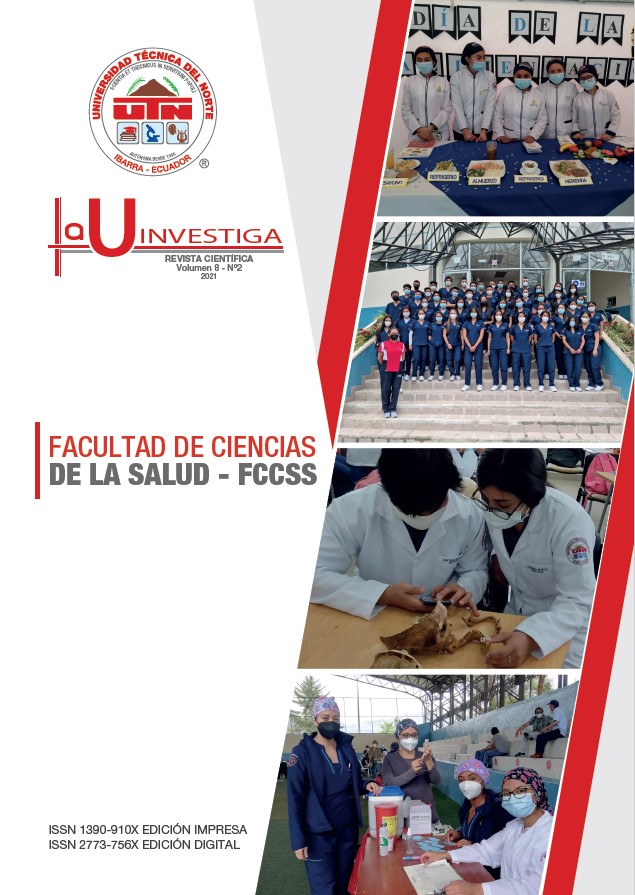Intervención Educativa: Riesgo de Contagio por VIH en Estudiantes Universitarios
Educational Intervention: Risk of HIV contagion in university students
DOI:
https://doi.org/10.53358/lauinvestiga.v8i2.519Palabras clave:
intervención educativa, VIH - Sida.Resumen
El reconocimiento del riesgo, de contraer VIH, como la probabilidad de padecer o contraer esta enfermedad, conduce a transformar positivamente el estado de salud. Se realizó un estudio observacional, cuanti - cualitativo y de intervención educativa, por muestreo aleatorio estratificado, 146 estudiantes de la Universidad Técnica del Norte, con voluntad de participar y permanencia en la institución durante el tiempo de investigación.
Los estudiantes estuvieron comprendidos entre las edades de 17 – 23 años, el 55 % de las mujeres entre 18 – 20 años, igualmente los hombres, aunque en menos frecuencia de participantes, 28 %, el 70.8 %, refirió información sobre la enfermedad, lo que se modificó positivamente en el 100.0 % de este grupo. El 41 % identificaron las relaciones sexuales desprotegidas como principal riesgo, e igual porcentaje, obtuvo información sobre el tema desde su acceso a Internet. Se concluyó, con variaciones significativas en el conocimiento de universitarios sobre el tema.
Descargas
Citas
Manual de Procedimientos Estandarizados para la Vigilancia Epidemiológica VIH –SIDA. Dirección General de Epidemiología. México. 2012.
Boletín Anual. MSP. Ecuador. 2019.
Fadragas Fernández AL. Intervención sobre ITS/VIH/sida en adolescentes pertenecientes a dos consultorios del policlínico "Plaza" Rev Cubana Med Gen Integr [internet]. 2012 [citado 17 Abr 2017];28 (3):[aprox. 9 p.]. Disponible en: http://scielo.sld.cu/scielo.php?script=sci_arttext&pid=S086421252012000300005&lng=es&nrm=iso&tlng=es
Sarmiento Olivera M, Gómez Olivera I, Ordaz González AM, García Díaz CD, Casanova Moreno MC. Estrategia de intervención educativa en enfermedades de transmisión sexual. Rev Cienc Méd [internet]. 2012 [citado 17 Abr 2017]. Disponible en:http://scielo.sld.cu/scielo.php?pid=S156131942012000100006&script=sci_artte
Estruch RL, Ochoa SR, Villalón OM. Epidemia de VIH/sida en Cuba: 30 años de experiencia. Santiago de Cuba: Editorial Oriente; 2016.p. 25.
Vidal E. y Hernández B. Conductas sexuales de riesgo asociadas a las infecciones de transmisión sexual en adolescentes de una comunidad. 2017.
Cuba MINSAP. Infecciones de transmisión sexual: Pautas para su tratamiento. Ciudad de La Habana; 2016.
OMS: Infecciones de transmisión Sexual, Centro de Prensa, Nota descriptiva No. 110. Nov. 2013.
Departamento de ITS-VIH/sida. Actualización de la Estrategia Nacional de Prevención y Control de las ITS-VIH/sida, La Habana: 2016.
Álvarez MI, Domínguez G, Torre Navarro LM. Factores relacionados con el contagio de las infecciones de transmisión sexual en la adolescencia. Rev Haban Cienc. Méd. [Internet]. Ciudad de La Habana. Mar.-abr. 2014; [Consultado: 2020 Abr. 16] 13(2). Disponible en: http://scielo.sld.cu/scielo.php?script=sci_arttext&pid=S1729-519X2014000200012.
Browne KD, Hamilton-Giachritsis C. The influence of violent media on children and adolescents:a public-health approach. Lancet. 2005 Feb19-25; 365 (9460):702-10. Review. PubMed PMID: 15721477.
Pichón Riviere, Enrique. El Proceso Grupal: Del Psicoanálisis a la Psicología Social. Editorial Nueva Visión, Buenos Aires, 1985.
Watzlawick, Paul. Teoría de la Comunicación Humana. Editorial Herder, 1993.
Avogadro, M. Comunicación, seguridad y nuevas tecnologías: un trinomio de tiempos virtuales. Razón y Palabra, 2012. México.
Publicado
Cómo citar
Número
Sección
Licencia
Derechos de autor 2021 Carmen Cecilia Pacheco Quintana, Adriana Miniet Castillo, Secundino González Pardo

Esta obra está bajo una licencia internacional Creative Commons Atribución-NoComercial 4.0.
Los autores conservan los derechos de autor y garantizan a la revista el derecho de ser la primera publicación del trabajo al igual que licenciado bajo una Creative Commons Reconocimiento-NoComercial-CompartirIgual 4.0 Internacional License que permite a otros compartir el trabajo con un reconocimiento de la autoría del trabajo y la publicación inicial en esta revista. Los autores pueden establecer por separado acuerdos adicionales para la distribución no exclusiva de la versión de la obra publicada en la revista (por ejemplo, situarlo en un repositorio institucional o publicarlo en un libro), con un reconocimiento de su publicación inicial en esta revista.

La U Investiga by La U Investiga is licensed under a Creative Commons Reconocimiento-NoComercial-CompartirIgual 4.0 Internacional License.
Puede hallar permisos más allá de los concedidos con esta licencia en http://revistasojs.utn.edu.ec/index.php/lauinvestiga/index





